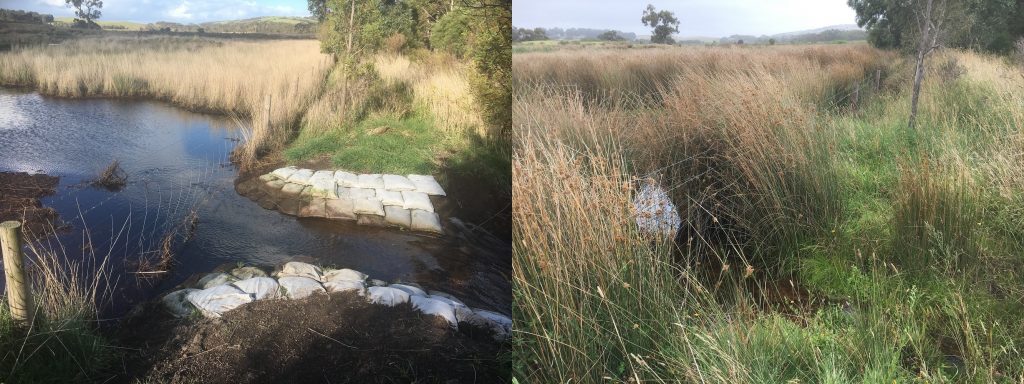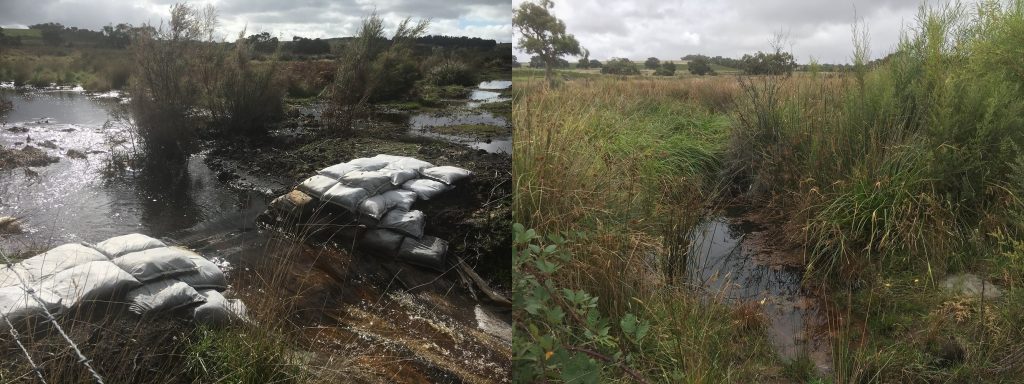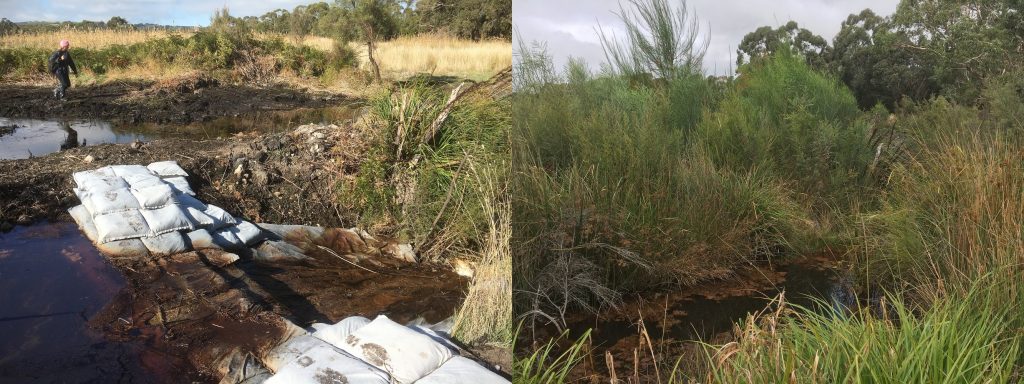The mysterious case of the disappearing sandbag structures…
Glenshera Swamp, the largest and most intact example of the critically endangered Fleurieu Peninsula Swamps ecological community, has been the focus of NGT hydrological restoration for over three years now. In April 2017 we back-filled several old drains that had been cut through the peat bed in the 1950s. Drain back-filling was done by machine and initially created quite a bit of disturbance, mostly to weedy pasture grasses, bracken and blackberry. However, we were confident that the restoration of wetter conditions within the swamp would, in time, favour native wetland species over these invaders – which has certainly turned out to be the case!
We also constructed several structures to consolidate and/or complement the drain back-filling works, by raising water levels and controlling the nature of flows leaving the swamp. The aim was to avoid causing any loss of the dehydrated, friable peat sediment (from the old spoil banks) that was used to fill in the drains and to carefully regulate the newly restored surface flows into the remaining 1-2 metre deep drain downstream. Setting up stable but inexpensive structures to navigate that significant drop in elevation is important for preventing erosion during high flow events – noting that once peat fully re-saturates, it is more stable and exhibits totally different physical properties which favour rapid recolonisation by plants. In itself, this process also helps to prevent the possibility of future erosion.
To build these structures we used the low cost, minimal engineering approach of geo-fabric sandbags that we have now employed at many other sites (see second half of this story for previous examples). Subject to the conditions that follow and the nature of material used to fill the bags, sandbag structures can sometimes be a little vulnerable at first. High flows can dislodge or undermine them, which led to us undertaking minor running repairs at a couple of locations. However, in time these structures “settle” and, under the right conditions (especially where the ground remains damp), wetland vegetation can quickly colonise the sandbags, helping to secure them into position.
We are happy to report that three years after construction, this process – and the recovery of native wetland vegetation – is now well advanced for our structures at Glenshera.
Despite being highly threatened, this is an ecological community capable of rapid vegetation change and recovery, when we specifically address the key ingredient the underpins its ecology. Like all wetland types, that key ingredient is the availability of water and restoring the right water regime – in this case, by bringing the water back to the surface of these swamps and re-saturating its underlying peat sediment, by simply back-filling the drains.
The before and after images below (as also illustrated in this previous article) speak for themselves. Some short term pain (i.e. disturbance), to achieve a long-term, self-sustaining gain…!

Structure 11 in August 2017 (left) and March 2020 (right). Note the displacement of introduced Phalaris pasture grass with native Juncus sarophorus upstream of the structure.

Structure 9 looking west in June 2017 (left) and March 2020 (right). The vegetation has regenerated naturally from the peat and includes a diverse range of native wetland herbs, sedges and shrubs.

Structure 9 looking north in August 2017 (left) and March 2020 (right). Permanent flows have allowed the recovery of dense and diverse native wetland vegetation typical of the Fleurieu Peninsula Swamp community where pasture grasses and bracken previously dominated. Sandbags are now covered in native plants.


